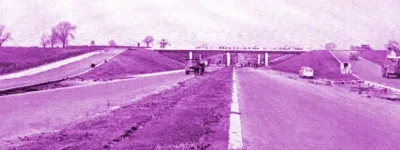
The outcome of the X-way consultation was the 1969 launch of the permanent solution for signalised pedestrian crossings: the X-way mark II. The consultation had conclusively thrown out the Ministry of Transport's idea that a white cross was necessary to distinguish the crossing from a conventional set of traffic signals and the new crossing had a green light, at a stroke making it much more intuitive to use. A proposal to paint a sort of cross design on the road just ahead of the crossing was also turned down after detailed diagrams had been made.
Among the other changes in the revised design was the timing. The X-way, like the Panda before it, had only a very short period where motorists saw a red light, and most of the pedestrian crossing phase was on 'flashing amber' where pedestrians had priority but vehicles could go if the way was clear. The idea was that the traffic lights should act like Belisha Beacons with the red time being kept as short as possible to prevent delays.
Unfortunately most pedestrians took the flashing green man to mean it wasn't safe to cross any longer and so there was usually a rush to get across the road in the few seconds protected by the red light. The new crossing, in response, had a much longer red light so that pedestrians felt safer and only used the flashing amber light towards the end. In addition, the push-button control was revamped with diagrams and clear instructions, and thankfully, the poorly understood reflective studs were removed from the approaches.
It will come as no surprise that the updated crossing was called the Pelican but it seems that name wasn't the obvious choice. The term 'Pelicon', an abbreviation of PEdestrian LIght CONtrolled crossing, had been used as shorthand in Ministry correspondence as early as 1965 when the Panda's replacement was first being discussed. But when that replacement was launched in 1967, a more snappy name was required, and the white cross on the traffic signal led to the X-way.
When it came to the 1969 relaunch, the white cross light and the cross on the road surface had been ditched, and in April 1968, the Ministry's J.P. Morris astutely noted that "the name X-ways seems a bit odd now that the X has gone from the lights", following his request for ideas with one strict rule — "no zoological names!"

In response, his colleague J. Mellor (with no relation to the noted designer who created the modern style traffic signal) agreed that animal names were out. He suggested making up a new term, and gave a list of ideas that were all equally terrible, including "Lightways", "Conways", "Sigways", "Safelanes", "Pedlights", "Pedways" and "Crosslights", though even he admitted he couldn't get "wildly enthusiastic" about any of them. In putting forward his ideas to his superiors, he argued that it was doubted whether "Pelicon" would "catch on with the public", and that it was "contrived and manufactured" (in a way, presumably, that "sigway" and "pedlight" are not). His two favourite proposals were "Lightways" or "Greenways".
By July 1968 the decision had been deferred again and again, and one recipient of the above memo, a Mr Jamieson, tried to hurry things along because the Minister was about to announce the scheme to the press and nobody knew what the infernal thing was called. He wrote:
"We are not too happy with your choice of either LIGHTWAYS or GREENWAYS. Mr Garrish is personally not in favour on the grounds that the former sounds too inter-planetary and the latter too rustic."
In response, Mellor confirmed he could never work in marketing by suggesting another new idea, "Watchmen", on the grounds that it would watch over the pedestrian and that the term may be applied to the red and green men in publicity material. He then grudgingly admitted that "Pelicon" was "probably the best of a bad bunch".
And so — with a tweak from the press office to give it a conventional spelling — the Minister's press release went along with the silly shorthand term almost by default, and the Pelican was born.
The Pelican Crossing was fast to establish itself across Britain as the pedestrian crossing of choice. It goes without saying that its name, despite the misgivings of the civil servants who coined it, was embraced by the public and has now virtually replaced all other terms for "pedestrian crossing" except for the Zebra. More modern variants of the traffic signal crossing like the Puffin or Toucan might have their own clever bird names, but to the British public they will probably always remain Pelicans, like it or not.
The Pelican had been intended to use the new-style Mellor signal heads, designed to provide a sleek, new design for signals across the country and due to launch in 1969. Unfortunately they weren't ready until late 1970 due to problems with the new design and so the very first Pelicans — some 700 of them, according to some reports — were installed using older-style SGE signal heads and X-way style rectangular pedestrian signals. They were converted, at enormous cost, in 1973.
The irony, of course, is that the Pelican had taken several stages of lengthy and expensive development and a well-publicised launch to create something that had already existed thirty years before. After just a few years of refinement, Forest City's 1930s crossings had quickly established that the best way to do things was a conventional set of signals for traffic and a two-light signal for pedestrians. The Pelican crossing was the result of more than a quarter of a century of meddling, in which time the only lasting innovations were that the pedestrian signals became a red and green man and the flashing amber phase was perfected. The government heralded the Pelican as something new and innovative. It wasn't.
